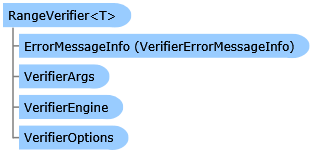
| Visual Basic (Declaration) | |
|---|---|
Public Class RangeVerifier(Of T As {New, Struct}) Inherits PropertyValueVerifier Implements System.IComparable(Of Verifier) | |
| Visual Basic (Usage) |  Copy Code Copy Code |
|---|---|
Dim instance As RangeVerifier(Of T) | |
| C# | |
|---|---|
public class RangeVerifier<T> : PropertyValueVerifier, System.IComparable<Verifier> where T: new(), struct | |
| C++/CLI | |
|---|---|
generic<typename T> public ref class RangeVerifier : public PropertyValueVerifier, System.IComparable<Verifier> where T: gcnew(), value class | |
- T
- The datatype of the property that is being verified
Because a range can be open ended on either the minimum or maximum end of the range many of the constructor overloads allow setting the RangeVerifier<T>.MinValue and RangeVerifier<T>.MaxValue values to null. This means that either no lower bound or no upper bound test will be performed during verification. Many constructor overloads also allow the specification as to whether the endpoints specified should be included within the range or not. Finally, most constructors will allow for the specification at to whether if a null value is encountered it should be considered an error or a completely valid value (implying that the specified range tests should NOT be performed).
System.Object
IdeaBlade.Validation.Verifier
IdeaBlade.Validation.PropertyValueVerifier
IdeaBlade.Validation.RangeVerifier<T>
IdeaBlade.Validation.DateTimeRangeVerifier
IdeaBlade.Validation.DecimalRangeVerifier
IdeaBlade.Validation.DoubleRangeVerifier
IdeaBlade.Validation.Int32RangeVerifier
IdeaBlade.Validation.Int64RangeVerifier
IdeaBlade.Validation.StringLengthVerifier
Target Platforms: Windows 98, Windows NT 4.0, Windows Millennium Edition, Windows 2000, Windows XP Home Edition, Windows XP Professional, Windows Server 2003 family, Windows Vista, Windows Server 2008 family




